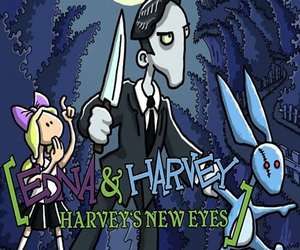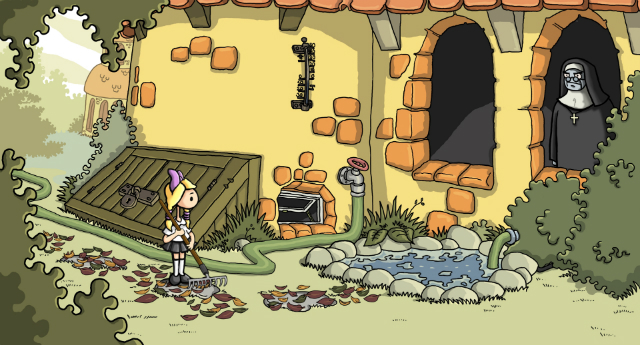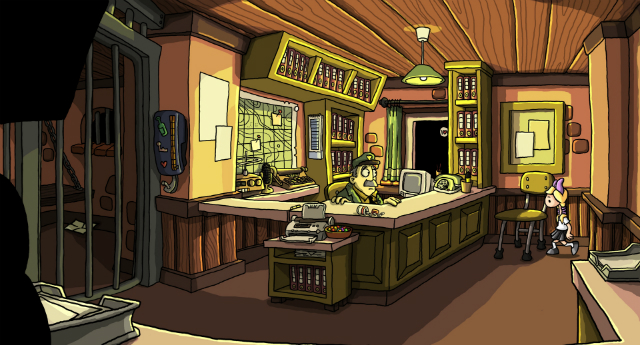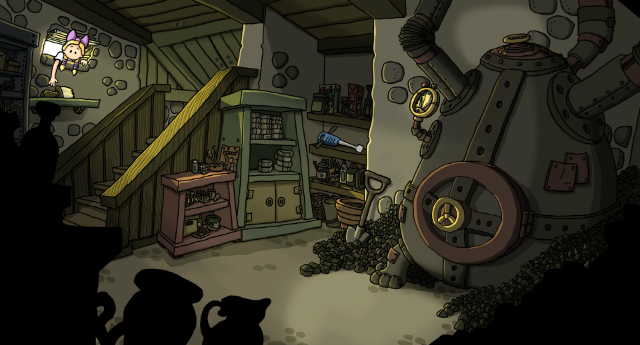Edna & Harvey: Harvey’s New Eyes Review
 Game: Edna & Harvey: Harvey’s New Eyes
Game: Edna & Harvey: Harvey’s New Eyes
Developer: Daedalic Entertainment
Publisher: Daedalic Entertainment
Available on: Windows PC only
Independent German adventure game developers Daedalic Entertainment burst onto the gaming scene with Edna & Harvey: The Breakout almost five years ago. The game, which began life as a university project, became a huge hit in their native country, and was even translated into English and sold around the world, both online and even in a boxed retail version. Pretty good for a game that was never originally intended for release to the public.
Now, fast forward to 2012 and Daedalic have made quite a name for themselves in the last half-decade. With a series of popular adventures such as The Whispered World, A New Beginning and, more recently, Deponia, the developers have carved out a fine reputation amongst fans of the genre for their strong story-telling, sense of humour and impressive visual style. Deponia has already spawned a sequel, which will be released later this year, so why wouldn’t the company want to continue the story of their original game, and bring back Edna & Harvey? Well that is exactly what they have done, with spin-off title Harvey’s New Eyes.

STORY: The game is set after the action seen in the first game, where young girl Edna escaped from an insane asylum with the help of her talking cuddly Rabbit toy, Harvey. They broke out after discovering a terrible conspiracy, and avoided the clutches of the evil, twisted psychologist Dr. Marcel. Now, sometime later, we find ourselves at a Catholic convent school, where a series of troubled children are taught by a rather short-fused Mother Superior. One of these is Lilli, a very quiet girl who is very well behaved, but bad luck seems to follow her around. She also happens to be best friends with a new girl at the convent; called Edna.
Players don’t control Edna at all in this game, and it plays much like a spin-off title, but obviously characters and aspects from the first title carry over into this one. As Mother Superior loses patience with her young charges, she enlists the help of a child psychologist, who just so happens to be the famous Dr. Marcel. Of course, alarm bells rings for Edna and she asks for the help of Lilli to escape the convent and to expose the doctor to the world. This will lead Lilli through an adventure full of death and destruction, but all in a cartoon world where all the violence in shown through rose-tinted glasses; quite literally. Because Lilli is so accident prone, a lot of her actions will inadvertently lead to the injury – or death – of other characters, but because she is so sweet and innocent, rather than seeing blood and gore, she sees small gnomes, painting purple splashes where the blood would be. This is not explained to begin with, so it’s a bit confusing, but players will soon realise what is going on, and it becomes a regular occurrence. This is funny, but obviously in a very dark way.
GRAPHICS: As mentioned, the visual style is a cartoon one, and both character sprites and backgrounds are all relatively simple. That is not to say the graphics are bad, but they aren’t particularly impressive. This is probably an intentional choice though, as it helps soften the edge of some of the violence players will encounter in the story, and some of the issues that arise. If the graphics were a bit more realistic, the game may seem a bit gritty and grim with some of the events. The characters are, somehow, still quite expressive and well-animated, despite the very simple sprites – most of them don’t even have noses or eyebrows – so it would traditionally be difficult to express emotion, but the art team still make a good shake of it. The only issue would be that the child-like art style might well put off a lot of potential players. It may give the the impression that the game is for younger children and may not take it seriously as a gaming option.

SOUND: The first thing you will notice of the sound design is the music. The opening credits start off with a melancholy ballad sung by the designer of the game – who also sang a number of songs in Deponia. That aside, the music is very atmospheric, and helps in a great way to set the tone of the game, mixing the innocence of children with the foreboding of the impending doom. A jazzy/blues musical style is mixed with some obviously religiously-inspired music, which makes the convent feel like an oppressive place, but also plays on the naïveté of Lilli.
The game is also fully voiced, which by and large is performed very well. Voices for children are often quite difficult to get right, but those on show here are quite convincing, whilst still being clear and coherent; despite the fact that heroine Lilli never speaks. This is a running gag, as whenever she is about to talk, people finish her sentences for her. Even the narrator will speak for her, letting the player know what she is thinking, rather than saying it. This too is funny, and it is an interesting concept, that we never really hear what the hero thinks throughout the game. One of the main issues players had with the first title was an awful translation from German to English. Whilst there are some minor issues again, there is nothing too bad this time around, and most of the jokes make sense, with little being lost in translation.
GAMEPLAY: The game plays like most popular adventure games, with a mouse-controlled cursor and different hotspots scattered around different locations that you will be able to explore. Unlike the first game, which had a table of verbs to choose from for interactions – such as look, talk, use, pickup – this game cuts out some of the fiddly clicking by using an adaptive cursor. The right mouse button will always act as your eye or look function on the cursor, whereas the left mouse button will change, depending in what you are hovering over. It will become a speech bubble over people you can talk to, or a hand over something you can pick up, for example. This makes the whole interaction process much quicker, and does help streamline the gameplay experience. The verb list would have now been very old-fashioned, as most adventures now adopt this adaptive cursor.

There is no hint system, like players will find in many modern adventure games, but instead, holding the space bar will show all of the hotspots on the current screen. This is a big help, as a common problem in adventure games is the pixel hunting that occurs when hotspots in a game are too small, here players will never miss a hotspot. It does, however, make the game a little easier, knowing where everything is and acting as a kind of hint of what to interact with next. Experienced adventurers will do well to try and ignore this feature.
The most innovative feature in the game is the way that the main character deals with breaking the rules. Part-way into the game, Lilli is hypnotised by Dr. Marcel so that she will obey the orders of Mother Superior. He uses the cuddly rabbit Harvey, with a new pair of hypnotic eyes, to convince her not to play with fire, to follow the orders of elders and not to steal, for example. This means that you will come across puzzles you cannot solve, for instance one where you need to light a torch on fire. If Lilli attempts to break a rule, she gets an electric shock and Harvey tells her off.
These rules appear as a sub-menu at the base of the screen, like an inventory. To overcome a rule, Lilli must force herself to re-enter a hypotonic trance and overcome her demon by outwitting them or convincing them she needs to perform a certain action. For example, she melts her ice demon with fire, to allow her to play with fire back in the real world. Once this is done, the player can select this rule from the sub-menu at any time, allowing Lilli to break the rule with no repercussions; but only one at a time. This is a really different aspect of the game compared to other titles, making for quite unique gameplay at times, and actually figuring out how to overcome the demons requires a different type of thinking than for the regular puzzles.

LONGEVITY: Although the game is only made up of three chapters, each chapter will definitely keep you busy for a decent amount of time, with the first two sections being particularly long. Expect to play the game for at least a good ten hours, but probably more, which is more than decent for a modern, independent adventure. As is the issue with almost all point and click games however, the title is pretty linear and there really isn’t much on offer to warrant repeat play-throughs.
There are achievements to earn via Steam, but these will all unlock via regular story progression so aren’t a big challenge, and the game does offer three distinct endings. Unfortunately, all of the endings are determined by one decision that is right near the end of the game so this won’t alter the way you play the game. If players wanted to see all the endings, they could simply re-load a save-game just before the decision in question. As such, once you have completed this game once, that will probably be it for the title, so all the better that it has a lengthy story to tell.
VERDICT: Harvey’s New Eyes certainly won’t be everyone’s cup of tea. It is a strange tale that hides a very dark sense of humour beneath its child-like exterior. There is the unique overcoming your demons gameplay, and some solid puzzles, but the whole thing might just seem a little too weird for some players. Indeed, the German sense of humour has been translated well, but will still seem pretty weird to many players, and some of the strange things just aren’t explained clearly to the player, meaning you have to come to your own conclusions.
It is a long title, but the ability to show hotspots and the fact that the more difficult puzzles can even be skipped by the player if they are struggling does make the game a little easy, especially compared to its predecessor. However, one of the main issues is that the presentation will put off some players before they even get started, which would be unfair on the developers. True, it is far less polished than their recent Deponia, and not as accessible, but it still tells a funny story, in an interesting way. You just have to work past a few layers if weirdness and confusion before you get into it.






